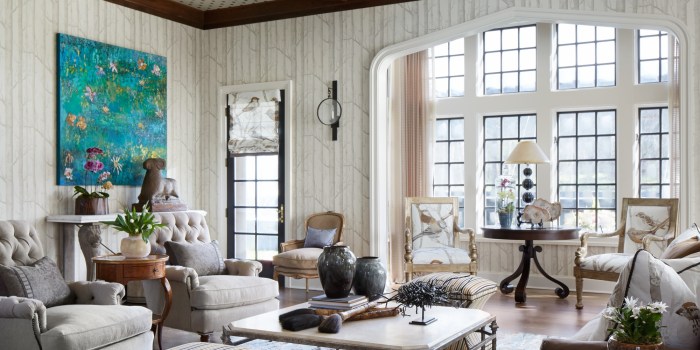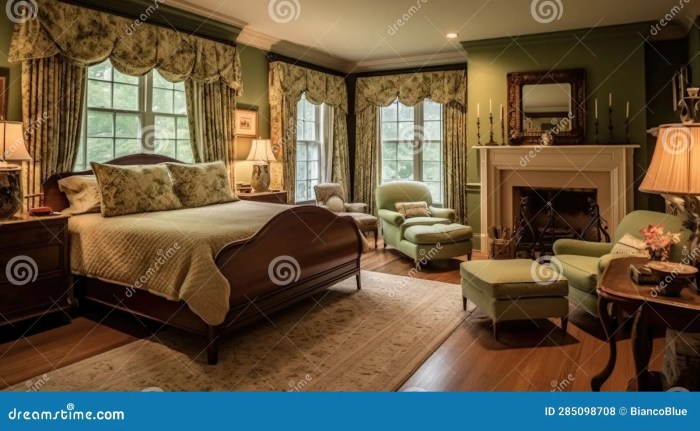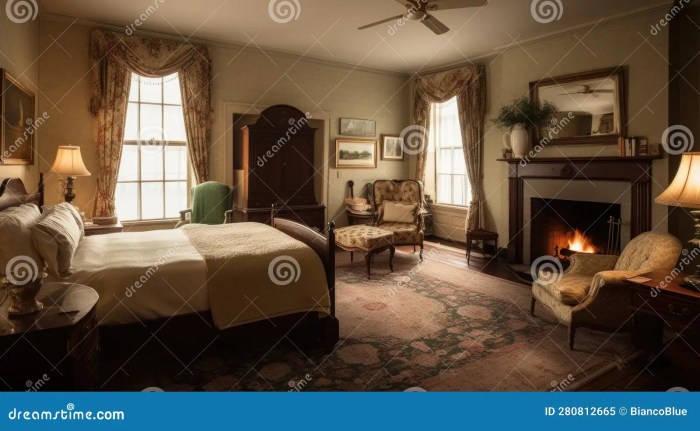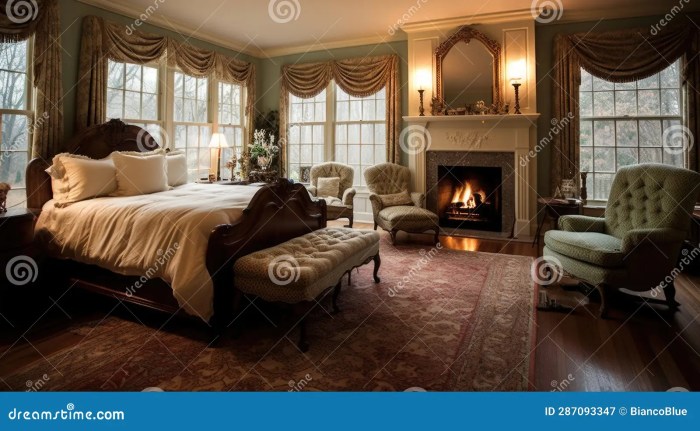Step into the refined elegance of Colonial-style classic bedrooms, a design aesthetic deeply rooted in history and craftsmanship. From the sturdy four-poster beds echoing centuries past to the carefully chosen fabrics whispering tales of colonial life, these spaces offer a unique blend of historical authenticity and enduring comfort. This exploration delves into the defining characteristics of this style, tracing its evolution across various regions and highlighting the meticulous details that set it apart.
We will examine the materials, color palettes, and furniture essential to capturing the essence of a Colonial-style bedroom, whether embracing a traditional or contemporary interpretation.
The journey begins with a comprehensive analysis of the key design elements, including regional variations like American and Dutch Colonial styles. We’ll uncover the historical influences that shaped these designs, from the practical needs of early settlers to the evolving tastes of subsequent eras. The discussion then transitions to the crucial role of color palettes and fabrics, exploring traditional and modern choices that complement the overall aesthetic.
Finally, we will investigate the furniture, lighting, and accessories that contribute to the unique atmosphere of a Colonial-style bedroom, showcasing diverse examples ranging from grand master suites to more minimalist interpretations.
Defining Colonial Style in Bedrooms
The Colonial style in bedroom design reflects a rich tapestry of historical influences, primarily stemming from the 17th and 18th centuries when European powers established colonies in various parts of the world. These styles, while sharing common threads, evolved distinctly based on regional resources, cultural exchanges, and the prevailing architectural trends of the time. Understanding these nuances is key to appreciating the diversity and enduring appeal of Colonial bedroom aesthetics.
Colonial bedroom design is characterized by a blend of simplicity and elegance, prioritizing functionality and durability. Common features include the use of natural materials, such as wood, often in dark, rich tones. Furniture is typically sturdy and handcrafted, featuring clean lines and understated ornamentation. Color palettes often employ muted earth tones, creams, and greens, reflecting the natural environment.
Bedrooms often incorporated built-in features like window seats or closets, maximizing space efficiency, a practical necessity in older homes.
Regional Variations in Colonial Bedroom Styles
The term “Colonial” encompasses a broad spectrum of styles, varying significantly depending on the colonizing power and the geographical location. American Colonial, for instance, often showcases a simpler, more utilitarian aesthetic compared to the more ornate Dutch Colonial style. American Colonial bedrooms frequently feature four-poster beds made of pine or maple, simple chests of drawers, and smaller-scale furniture reflecting the practicality of early American life.
In contrast, Dutch Colonial bedrooms, particularly those found in New York and New Jersey, might exhibit more elaborate detailing, including curved lines, decorative moldings, and the use of richer woods like cherry or walnut. These differences reflect the distinct cultural and material resources available in these different regions. The Spanish Colonial style, prevalent in the southwestern United States and Latin America, often incorporates elements of indigenous craftsmanship, featuring stucco walls, intricate ironwork, and vibrant color palettes influenced by the local environment.
Historical Influences on Colonial Bedroom Aesthetics
The aesthetics of Colonial bedrooms are deeply rooted in the historical context of their creation. Early American Colonial design, for example, was influenced by the simple, functional styles prevalent in 17th-century England. The emphasis on handcrafted furniture reflects the limited access to mass-produced goods and the importance of skilled artisans. Later, as trade expanded, influences from other European styles, such as Georgian and Rococo, began to seep into Colonial design, resulting in a gradual shift towards more ornate details and a greater emphasis on luxury.
The availability of new materials and technologies also impacted design, leading to the use of more sophisticated joinery techniques and the incorporation of decorative elements like carved moldings and inlaid wood. These historical shifts are clearly reflected in the evolution of Colonial bedroom furniture over time.
Materials and Craftsmanship in Colonial-Style Furniture
Colonial-style furniture is renowned for its high-quality materials and meticulous craftsmanship. The most commonly used woods include pine, maple, cherry, walnut, and mahogany. These woods were selected for their durability, workability, and aesthetic appeal. Craftsmen employed traditional joinery techniques, such as mortise and tenon joints, dovetail joints, and pegged construction, ensuring the strength and longevity of the furniture.
The finish was often achieved through hand-rubbed techniques, enhancing the natural beauty of the wood and protecting it from wear and tear. The simplicity of the designs often belied the sophisticated craftsmanship involved, a testament to the skill and artistry of the furniture makers. The use of hand-forged iron hardware, often with simple but elegant designs, further contributed to the overall aesthetic of Colonial-style bedroom furniture.
Color Palettes and Fabrics

The selection of color palettes and fabrics is crucial in achieving the authentic ambiance of a Colonial-style bedroom. These choices, informed by the historical context and the inherent qualities of the materials, directly contribute to the overall aesthetic and feeling of the space, evoking a sense of history and timeless elegance. Understanding the typical color palettes and fabric choices employed in Colonial-era homes provides a solid foundation for creating a historically informed and aesthetically pleasing design.
Color palettes in Colonial-style bedrooms were often inspired by the natural environment and the readily available dyes of the time. Subtle, muted tones were favored, reflecting a sense of calm and understated sophistication. The use of natural light was also a key consideration, influencing the choice of colors to optimize the room’s brightness and overall atmosphere.
Colonial Bedroom Color Palettes
The following table showcases typical color palettes used in Colonial-style bedrooms. These palettes draw inspiration from historical examples and reflect the preferences of the era. Note that the specific shades can vary based on regional influences and the availability of pigments.
| Palette Name | Primary Colors | Accent Colors | Overall Mood |
|---|---|---|---|
| Classic Colonial | Cream, Soft White, Pale Green | Muted Blue, Warm Brown | Serene, Tranquil |
| Southern Plantation | Warm White, Soft Yellow, Pale Gray | Deep Teal, Brick Red | Inviting, Rustic |
| New England Charm | Off-White, Light Gray, Dusty Blue | Forest Green, Charcoal Gray | Refined, Sophisticated |
| Early American | Beige, Light Brown, Soft Peach | Terracotta, Deep Green | Warm, Earthy |
Three Distinct Colonial Bedroom Color Schemes
These examples illustrate how different color palettes can create unique atmospheres within a Colonial-style bedroom. Each scheme includes paint colors, fabric choices, and accent piece suggestions to provide a comprehensive design concept.
Scheme 1: Serene Coastal
-Walls: Soft White (#FAFAFA). Fabrics: Linen bedding in pale blue and white stripes, cotton window treatments in a light seafoam green. Accent Pieces: Whitewashed wood furniture, wicker baskets, seashell accents.
Scheme 2: Rustic Charm
-Walls: Warm Beige (#F5F0E1). Fabrics: Cotton chintz bedding with a small floral print in muted reds and greens, wool area rug in a deep brown. Accent Pieces: Dark wood furniture, wrought iron candle holders, antique mirrors.
Scheme 3: Elegant Simplicity
-Walls: Light Gray (#D3D3D3). Fabrics: Linen bedding in a solid ivory, velvet throw pillows in deep teal. Accent Pieces: Silver-toned hardware, polished wood furniture, antique brass lamps.
Traditional and Contemporary Fabric Choices
The choice of fabrics significantly impacts the overall aesthetic and tactile experience of a Colonial-style bedroom. Traditional and contemporary options offer diverse possibilities, allowing for a balance between historical accuracy and modern sensibilities.
Traditional Fabrics: Damask (a rich, woven fabric with raised patterns), chintz (a printed cotton fabric), toile (a printed cotton fabric with a repeating pattern, often featuring pastoral scenes), linen (a natural fiber known for its durability and breathability), and wool (a natural fiber offering warmth and texture). These fabrics often feature floral motifs, stripes, or classic geometric patterns reflecting the design sensibilities of the Colonial period.
Contemporary Fabrics: While maintaining the spirit of the Colonial style, contemporary fabrics can offer a more modern twist. Think linen blends with subtle textures, cotton sateen with a sheen, or even a high-quality microfiber that mimics the look and feel of natural fibers. Patterns can be more abstract or minimalist while still incorporating muted color palettes and classic elements.
The Use of Natural Fibers
Natural fibers like linen and cotton were prevalent in Colonial-era homes due to their availability and practicality. Linen, known for its durability, breathability, and luxurious drape, was often used for bedding and curtains. Cotton, readily cultivated in many Colonial regions, provided a softer, more affordable alternative for various textile applications. The use of these natural fibers not only reflects the historical accuracy of the style but also contributes to a more sustainable and environmentally friendly approach to interior design.
Their inherent textures and subtle variations in color add to the overall charm and authenticity of a Colonial-style bedroom.
Furniture and Accessories
The careful selection of furniture and accessories is paramount in achieving an authentic Colonial-style bedroom. These elements, reflecting the craftsmanship and aesthetic sensibilities of the era, contribute significantly to the overall atmosphere of historical elegance and refined simplicity. The pieces chosen should evoke a sense of timelessness, reflecting the enduring appeal of Colonial design.
Colonial-style bedroom furniture is characterized by its sturdy construction, often using hardwoods like cherry, mahogany, or walnut. The designs frequently incorporate classic joinery techniques, reflecting a commitment to quality and durability that transcends fleeting trends. Simpler lines and understated elegance are key, avoiding excessive ornamentation while still possessing a distinct visual appeal. The functionality of each piece is also emphasized, reflecting the practical needs of the time.
Essential Furniture Pieces
A Colonial-style bedroom typically centers around several key furniture pieces. These items not only serve practical purposes but also contribute to the room’s overall aesthetic cohesion. The careful selection and placement of these pieces are crucial in establishing the desired ambiance.
The four-poster bed, a defining feature, provides a strong visual anchor. Its tall posts, often intricately carved or turned, support a canopy, which could be made of fabric or even a decorative wooden structure. A substantial dresser, with multiple drawers for storage, typically features simple lines and sturdy handles. Nightstands, often matching the dresser in style, provide convenient surfaces for lamps and personal items.
A wardrobe or armoire, for clothing storage, is another common element, offering additional functionality and aesthetic continuity.
Design Features of Colonial-Style Bedroom Furniture
Detailed examination of the design elements reveals the inherent elegance of Colonial-style furniture. The use of natural wood finishes, often showcasing the inherent beauty of the grain, is a hallmark of the style. Simple, functional designs, avoiding overly elaborate ornamentation, reflect the practical sensibilities of the era.
Common design elements include turned legs, often featuring tapered or baluster shapes, and simple, sturdy drawer pulls. The use of dovetail joinery, a strong and aesthetically pleasing woodworking technique, is often visible, demonstrating the quality of craftsmanship. Mouldings and decorative carvings are sometimes present, but they are generally understated and elegant, complementing the overall simplicity of the design.
The overall impression is one of refined simplicity and enduring quality.
Common Accessories
Accessories play a vital role in completing the Colonial-style bedroom. These items, chosen carefully, enhance the atmosphere and add layers of detail that contribute to the overall aesthetic. The selection of accessories should be consistent with the overall style, maintaining a sense of unity and harmony.
Mirrors, often framed in wood that complements the furniture, are a practical and decorative element. Lamps, with simple bases and shades, provide soft, ambient lighting. Rugs, made from natural fibers such as wool or cotton, add warmth and texture to the floor. Curtains, in simple fabrics like linen or cotton, complete the look, contributing to a sense of comfort and privacy.
Small decorative items, such as antique books or framed botanical prints, can add further character and personality to the space.
Incorporating Antique or Antique-Inspired Pieces
Integrating antique or antique-inspired pieces seamlessly into a modern Colonial-style bedroom requires careful consideration. The goal is to create a cohesive space that blends historical elements with contemporary functionality. The key is to strike a balance between authenticity and modern comfort.
A genuine antique piece, such as a vintage dresser or nightstand, can serve as a focal point, adding a layer of historical depth to the room. Alternatively, selecting high-quality reproductions that accurately replicate the look and feel of antique furniture can achieve a similar aesthetic without the cost or fragility associated with genuine antiques. When combining antique and modern elements, it’s crucial to maintain consistency in the color palette and overall style, ensuring a unified and harmonious atmosphere.
The careful selection and placement of these pieces are crucial in achieving a successful blend of old and new.
Lighting and Ambiance

The successful evocation of a Colonial-style bedroom hinges significantly on the careful manipulation of light. Proper lighting isn’t merely about illumination; it’s about crafting an atmosphere that whispers of history, comfort, and refined elegance, mirroring the era’s aesthetic sensibilities. The interplay of natural and artificial light sources is crucial in achieving this nuanced ambiance.Lighting design in a Colonial-style bedroom should mimic the available light sources of the era, while incorporating modern conveniences.
The goal is to create a layered approach, utilizing multiple light sources to avoid harsh shadows and enhance the room’s textures and furnishings. This multi-faceted approach to lighting contributes significantly to the overall feeling of warmth and intimacy.
Colonial Bedroom Lighting Plan
A comprehensive lighting plan for a Colonial bedroom necessitates a blend of ambient, task, and accent lighting. Ambient lighting provides overall illumination, task lighting focuses on specific areas needing brighter light, and accent lighting highlights architectural details or decorative elements. Consider these placements:A central ceiling fixture, perhaps a reproduction of a period chandelier or a simpler, elegant flush mount, serves as the primary ambient light source.
This should be complemented by wall-mounted sconces flanking a bed or dresser, providing softer, more focused illumination. These sconces could be styled with frosted glass or simple candle-like designs to maintain the period aesthetic. Finally, task lighting can be provided by table lamps on nightstands, featuring classic designs like tapered shades or simple, elegant bases. The use of dimmer switches on all fixtures allows for adjusting the intensity to suit the mood and time of day.
Natural Light Enhancement
Maximizing natural light is paramount in achieving the desired ambiance. Large windows, a hallmark of many Colonial homes, should be kept uncluttered to allow maximum light penetration. Sheer, lightweight curtains in a neutral color palette, such as off-white or cream linen, can be used to soften the light and provide privacy without sacrificing brightness. These curtains, when drawn back during the day, allow ample natural light to bathe the room, highlighting the richness of the wood furniture and the texture of the fabrics.
Mirrors strategically placed near windows can further amplify the natural light, creating a brighter, more airy feel.
Soft Lighting for Warmth
While electric lighting provides practicality, incorporating softer lighting options enhances the atmosphere’s warmth and intimacy. Candles, in appropriately sized holders, placed on mantles, dressers, or nightstands, evoke the historical ambiance perfectly. The soft, flickering light creates a romantic and comforting atmosphere, reminiscent of bygone eras. Furthermore, strategically placed oil lamps (for decorative purposes, with proper safety precautions) or LED candles mimicking the flame effect can provide a similar warm glow without the fire hazard.
These elements work in tandem with the other light sources to create a layered and inviting space.
Illustrative Examples

The following examples demonstrate the versatility of the Colonial style in bedrooms, showcasing different interpretations and levels of formality while adhering to the core design principles. These examples highlight how variations in furniture, materials, and architectural details can create distinct yet equally authentic Colonial atmospheres.
A Colonial Bedroom with a Canopy Bed
This bedroom features a majestic mahogany four-poster canopy bed, its rich, dark brown hue enhanced by a hand-rubbed finish. The bedposts, meticulously carved with acanthus leaf motifs – a common feature in 18th-century Colonial design – rise to support a crisp white linen canopy, creating a sense of refined elegance. The bed is dressed in high-thread-count Egyptian cotton sheets in a creamy off-white, complemented by a patchwork quilt showcasing muted blues, greens, and creams.
A handcrafted wool rug in a similar color palette anchors the space. Flanking the bed are matching nightstands, crafted from the same mahogany, featuring simple yet elegant drawer pulls. These nightstands hold antique brass table lamps with ivory shades, casting a warm, inviting glow. A large antique mirror hangs above a simple dresser, further enhancing the sense of spaciousness and light.
The overall effect is one of stately grandeur tempered by a sense of cozy comfort.
A Minimalist Colonial Bedroom
In contrast to the previous example, this bedroom embraces a minimalist approach to Colonial style, prioritizing functionality and clean lines. The walls are painted in a soft, neutral shade of gray-beige, allowing the architectural details – such as simple crown molding and chair rail – to take center stage. The bed is a simple platform bed made of light oak, its unadorned design emphasizing its natural grain and texture.
The bedding consists of crisp white linen sheets and a lightweight cotton duvet, creating a sense of airy simplicity. A single, functional nightstand with a built-in drawer provides ample storage. A simple woven jute rug adds texture without overwhelming the space. Instead of ornate accessories, a few carefully selected pieces—a vintage botanical print, a simple ceramic vase—add personality without sacrificing the clean aesthetic.
The overall feel is one of calm sophistication, showcasing the beauty of simplicity within the Colonial framework.
A Colonial Master Bedroom Suite
This master suite seamlessly integrates bedroom, dressing area, and en-suite bathroom, creating a luxurious and cohesive space. The bedroom, much like the minimalist example, features light oak flooring and walls painted in a warm, creamy white. A large four-poster bed, however, boasts a simpler design than the previous example, featuring clean lines and a natural finish. The dressing area, separated from the bedroom by a graceful arched doorway, features a built-in wardrobe with ample storage space and a large, antique vanity mirror with a matching dresser.
The vanity is made of dark stained cherry wood, contrasting elegantly with the lighter tones of the bedroom. The en-suite bathroom maintains the Colonial theme through the use of white subway tiles, a claw-foot bathtub with nickel fixtures, and a marble countertop. Brass accents are subtly incorporated throughout the suite, maintaining a sense of cohesion. The overall design speaks of refined luxury and understated elegance.
Architectural Details in Colonial Bedrooms
The use of architectural details is crucial in establishing a true Colonial aesthetic in a bedroom. Crown molding, typically featuring intricate detailing, adds a sense of grandeur and sophistication. Wainscoting, often reaching halfway up the walls, provides both visual interest and protection to the lower portion of the walls, a practical feature in the Colonial era. Baseboards, wider than modern counterparts, add to the overall sense of scale and proportion.
These elements, combined with the use of built-in cabinetry and shelving, not only enhance the visual appeal but also reflect the functional practicality that characterized Colonial design. For instance, a detailed chair rail adds visual interest and protection to the walls, mirroring historical practices of protecting walls from chair backs and other furniture. These details create a sense of depth and richness, elevating the overall aesthetic of the room.
Final Review

In conclusion, designing a Colonial-style classic bedroom is a journey through time, a careful curation of historical influences and modern sensibilities. From the rich history informing the design choices to the meticulous attention to detail in furniture and fabrics, every element contributes to the creation of a space that is both timeless and inviting. Whether embracing a traditional or contemporary interpretation, the goal remains the same: to craft a sanctuary that evokes a sense of history, comfort, and enduring elegance.
By understanding the key principles of this style, one can create a bedroom that not only reflects the past but also serves as a haven for modern living.
Query Resolution
What are some modern updates to a Colonial-style bedroom?
Modern updates can include incorporating sleek, minimalist furniture alongside antique pieces, using updated lighting fixtures while maintaining a period-appropriate style, and selecting contemporary fabrics in traditional patterns or colors.
How can I achieve a Colonial-style bedroom on a budget?
Repurposing existing furniture, shopping for affordable antique or vintage pieces at flea markets or online, and using DIY techniques for smaller projects like creating a headboard or painting furniture can significantly reduce costs.
Are there specific safety considerations for antique furniture in a bedroom?
Yes. Ensure antique furniture is structurally sound and free of hazards like loose parts or lead paint. Regular inspections and appropriate restoration when needed are crucial for safety.
How do I choose the right size rug for a Colonial-style bedroom?
The rug should be large enough to anchor the bed and nightstands, extending at least 18-24 inches beyond each side of the bed. Consider the overall room size and the scale of the furniture when making your selection.
What are some common mistakes to avoid when designing a Colonial-style bedroom?
Overdoing the antique look, neglecting proper lighting, and choosing fabrics or colors that clash with the overall aesthetic are common pitfalls. Maintaining balance and a cohesive design is key.